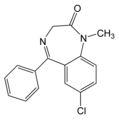Some patients with epilepsy are affected by acute repetitive, or serial, seizures that last several minutes or hours and do not follow the pattern of their usual seizures. Benzodiazepines are the drugs of choice for the treatment of acute repetitive seizures. They are safe and they work quickly. However, oral administration is often difficult in a patient who is actively convulsing. Dreifuss and colleagues performed a randomized, double-blind, parallel-group, placebo-controlled study to assess the safety and efficacy of at-home administration of rectal diazepam gel for acute repetitive seizures. The high lipid solubility of this form of diazepam allows for rapid absorption and penetration into the central nervous system.
The study included 91 patients aged two to 60 years who had had at least four episodes of repetitive seizures during the preceding year and at least one such episode in the previous three months. All patients had followed a stable antiepileptic regimen for at least four weeks before the beginning of the study. Patients were ineligible for the study if they were receiving long-term drug therapy other than anticonvulsants, had a phenobarbital level higher than 30 mg per L (130 [micro]mol per L) or were receiving long-term benzodiazepine therapy.
Caregivers were taught how to identify repetitive seizures, administer diazepam rectally, and monitor and record respirations, skin color, seizure activity and adverse events. When acute repetitive seizures occurred, the caregiver telephoned a nurse, who maintained constant contact. The caregiver reported on the patient's condition so the nurse could intervene if problems developed.
Rectal diazepam gel was administered in dosages of 0.5 mg per kg for children two to five years of age, 0.3 mg per kg for children six to 11 years of age and 0.2 mg per kg for children 12 years of age and older and for adults. A second dose was given four hours after the first and, in adults, a third dose was given eight hours after the second dose. The period of observation and data recording by caregivers began immediately after the first dose and continued for 12 hours in children and for 24 hours in adults.
Diazepam gel was found to be significantly more effective than placebo in reducing seizure frequency in both adults and children. This difference was noted as early as 30 minutes after the initial dose and continued throughout the observation period. The caregiver's global assessment of the treatment outcome was significantly higher for children receiving diazepam than for children receiving placebo, but no significant difference was observed in this outcome variable for adults in either group. None of the patients who received diazepam required emergency room treatment.
Adverse events were reported more commonly in the diazepam group (46.7 percent) than in the placebo group (30.4 percent), but the difference was not significant. The most commonly reported adverse effect in the patients receiving diazepam was somnolence (15 patients). No instances of respiratory difficulty occurred.
The authors conclude that rectal diazepam gel is safe and effective for acute repetitive seizures and can be administered by caregivers who know how to monitor the person's response. In an accompanying editorial, Vining states that the cost of rectal diazepam gel in the Baltimore area is about $70 to $90 for a 10-mg dose, compared with approximately $6 for a 10-mg vial of parenteral diazepam solution. Nevertheless, she states, the gel form has advantages. It is stable at room temperature, packaged in the specific dose prescribed for the patient and can be easily administered. She notes that diazepam gel would be useful, for example, when patients are traveling and a parenteral solution cannot be refrigerated, It also would be "a reassuring safety net" for patients who are prone to status epilepticus and who travel or live far from a hospital. However, she cautions that this formulation should not be used to prevent recurrent febrile seizures, and physicians should be careful that the fear of seizures does not lead to overprescribing of this drug.
Dreifuss FE, et al. A comparison of rectal diazepam gel and placebo for acute repetitive seizures. N Engl J Med June 25, 1998;338:1869-75, and Vining EP. Gaining a perspective on childhood seizures [Editorial]. N Engl J Med June 25, 1998;338:1916-8.
COPYRIGHT 1998 American Academy of Family Physicians
COPYRIGHT 2000 Gale Group



